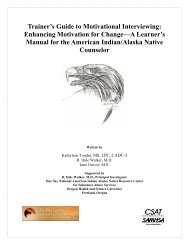An illustrated glossary by Zhaawano Giizhik*
You also want an ePaper? Increase the reach of your titles
YUMPU automatically turns print PDFs into web optimized ePapers that Google loves.
The Universe of The Ojibwe <strong>An</strong>ishinaabeg <strong>by</strong> <strong>Zhaawano</strong> Giizhik - 2014<br />
*In the process of composing this document, I respectfully borrowed and adapted some passages<br />
from the Noongwa e-<strong>An</strong>ishinaabemjig website, the book “Rites of Conquest” <strong>by</strong> Charles E. Cleland<br />
(University of Michigan 1992), ZhaawanArt art blog, the books “Ojibway Ceremonies” and<br />
“OjibwayHeritage” <strong>by</strong> Basil Johnston (Bison Book, University of Nebraska Press 1990), The<br />
Iconology, Manitou(s) and Metaphors of Josh Kakegamic <strong>by</strong> Leah Fontaine, the Article “The Spirit<br />
Powers of Ojibwe and Odawa Art” <strong>by</strong> Winona LaDuke (NMAI, fall 2000), <strong>An</strong>ishinaabemowin Circle<br />
Learning Guide Reference Book September 2010, Living With <strong>An</strong>imals <strong>by</strong> Michael Pomedi (University<br />
Of Toronto Press 2014), and “Minjimendaamowinon <strong>An</strong>ishinaabe” <strong>by</strong> Janice<br />
Acoose/Miskwonigeesikokwe (University of Saskatchewan). Also, sometimes text sources and<br />
images are marked <strong>by</strong> a hyperlink. The graphic art and jewelry shown on these pages are works<br />
<strong>by</strong> Woodland artists Norval Morrisseau (Miskwaabik <strong>An</strong>imikii; 1932-2007), Jackson Beardy (1944-<br />
1984), Alex Janvier (1935), Carl Ray (1943-1978), Abe Kakepetum, Frank Polson (1952), Leland<br />
Bebaminojmat Bell (1953), James Mishibinijima Simon (1954), Simone Mcleod (Aki-egwaniizid; 1962),<br />
Iwan Shawana, Chris <strong>An</strong>geconeb, <strong>Zhaawano</strong> Giizhik (1959), Christi Belcourt, and others.<br />
I gratefully and respectfully dedicate this <strong>illustrated</strong> <strong>glossary</strong> to my Ojibwe <strong>An</strong>ishinaabe<br />
ancestors who left their spirit and footprints at the beautiful rapids and falls of<br />
Baawitigong (Sault Ste. Marie, MI); to my sons Niiwino Djjibikag (Odji) and Wiigwaas<br />
Gitchiode’ (Gitchy) and each of their cousins so they will not forget where they come<br />
from; to Aki-egwaniizid (Simone McLeod) because she is my best friend and lovingly<br />
included me in her life and her amazing artistic and spiritual journey to the Dawn Land; and<br />
to my Kanienkehaka /Odaawaa Nishnaabe niijii, oshkinawe-ogichidaa Phillip Meshekey<br />
because he aspires to utilize his contemporary Turtle Medicine-inspired art expressions to<br />
build bridges between the younger and older <strong>An</strong>ishinaabeg generations. Chi-miigwech<br />
gakina awiiya inawemaaganag, miigwech gibzindaw, thank you all my relatives for listening.<br />
Pronunciation Guide<br />
All jewelry shown here and on <strong>Zhaawano</strong>’s web pages and blog posts have Ojibwe <strong>An</strong>ishinaabe (Chippewa)<br />
names. The language, <strong>An</strong>ishinaabemowin, forms one of the daughters of the great Algonquian<br />
(linguistic) stock, and is composed of a large variety of dialects; the disparities between, for instance,<br />
the northern (Canadian) and southern (U.S.) dialects are quite substantial. The words and names<br />
that you find on these pages more or less reflect these dialect differences. Being a spoken<br />
language, only recently people have begun to write it. Although there is no standard international<br />
orthography (yet), the below list is based on the Fiero Double Vowel orthography system. It is<br />
currently used in over 200 <strong>An</strong>ishinaabe communities in and around Quebec, Ontario, Manitoba,<br />
Saskatchewan, Alberta, North Dakota, Michigan, Wisconsin, and the international boundary.<br />
In the list below, Ojibwe vowels and consonants and English equivalents of the Ojibwe sounds<br />
are given. Although for written communication purposes the Fiero system was chosen as a crosscommunity<br />
and international orthography, the list does not represent the full range of vowels or the<br />
tones, nor does it reflect the enormous diversity of pronunciations and intonations that are typical of<br />
a specific region or community. Please note that accurate pronunciation cannot be learned without<br />
respectfully consulting a Native Ojibwe <strong>An</strong>ishinaabe speaker either in the U.S. or in Canada.<br />
_____________________________________________________________________________________________________<br />
13 approximate sounds of Ojibwe <strong>An</strong>ishinaabe vowels and consonants are given below.<br />
a = as in about, or sometimes as in luck<br />
aa = as in author but long in duration, pronounced with a certain emphasis.<br />
ay = as in <strong>by</strong>e.<br />
e = as in café, sometimes (but rarely) as in bed.<br />
i = as in pin<br />
ii = as in eel<br />
o = as in obey, and sometimes as in book<br />
oo = as in boat, and sometimes as in boot<br />
ch = as in chin<br />
j = as in judge<br />
ñ = a (French) nasal sound, sometimes written as ‘nh’ (occurring at the end of some words)<br />
These nasal sound are not always indicated in the below text.<br />
zh = as in pleasure<br />
‘ = glottal stop; represents a throaty release of air similar to the pause in “oh-oh”. A global stop<br />
is sometimes omitted in pronunciation.<br />
N.B.: All other consonants are (more or less) the same as in English.<br />
The Universe of The Ojibwe <strong>An</strong>ishinaabeg <strong>by</strong> <strong>Zhaawano</strong> Giizhik - 2014<br />
2




